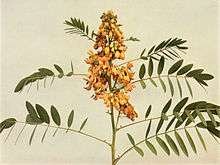Senna hebecarpa
| Senna hebecarpa | |
|---|---|
 | |
| Scientific classification | |
| Kingdom: | Plantae |
| (unranked): | Angiosperms |
| (unranked): | Eudicots |
| (unranked): | Rosids |
| Order: | Fabales |
| Family: | Fabaceae |
| Subfamily: | Caesalpinioideae |
| Tribe: | Cassieae |
| Subtribe: | Cassiinae |
| Genus: | Senna |
| Species: | S. hebecarpa |
| Binomial name | |
| Senna hebecarpa (Fernald) H.S.Irwin & Barneby [1] | |
| Synonyms | |
|
Cassia hebecarpa Fernald | |
Senna hebecarpa, with the common names American senna[3] and wild senna, is a species of legume native to eastern North America. [2][1][4] [5]
Distribution
The plant is found from the Great Lakes region and Maine southwards through the Eastern United States, in the Appalachian Mountains and Atlantic Plains, to Georgia. [2][6]
It is found in moist open woodlands, and in disturbed areas.[6]
Description
Senna hebecarpa grows as a sparsely branched perennial shrub. It has axils of compound leaves. [7]
Clusters of light yellow to orange flowers bloom through July and August in North America. [7]
Uses
The Native American Cherokee and Iroquois peoples used this as a traditional medicinal plant. [8]
Senna hebecarpa is cultivated as an ornamental plant, for use as a perennial wildflower and flowering shrub in traditional and wildlife gardens, in natural landscaping projects, and for habitat restoration projects.[7][4][5]
It is a larval host and nectar source for the Cloudless Giant Sulphur (Phoebis sennae) butterfly.[7] It is also of special value to native bumble bees [7] [9]
References
- 1 2 ITIS Standard Report Page: Senna hebecarpa
- 1 2 3 United States Department of Agriculture (USDA) (2014): Senna hebecarpa. Retrieved 8-24-2014.
- ↑ "Senna hebecarpa". Natural Resources Conservation Service PLANTS Database. USDA. Retrieved 10 November 2015.
- 1 2 Blanchan, N. (1916): Wild Flowers: An Aid to Knowledge of our Wild Flowers and their Insect Visitors. TXT fulltext at Project Gutenberg
- 1 2 Blanchan, N. (1917): Wild Flowers Worth Knowing. HTML or TXT fulltext at Project Gutenberg
- 1 2 NPGS—GRIN information: Senna hebecarpa (wild senna)
- 1 2 3 4 5 Lady Bird Johnson Wildflower Center Native Plant Information Network: ''Senna hebecarpa
- ↑ Senna hebecarpa Ethnobotany
- ↑ The Xerces Society for Invertebrate Conservation: Pollinator Conservation Program
External links
- USDA Plants Profile for Senna hebecarpa (American senna)
- University of Michigan—Dearborn: Native American Ethnobotany of Senna hebecarpa
- Connecticut Botanical Society: Senna hebecarpa
- Illinois Wildflowers: Senna hebecarpa
| Wikimedia Commons has media related to Senna hebecarpa. |
